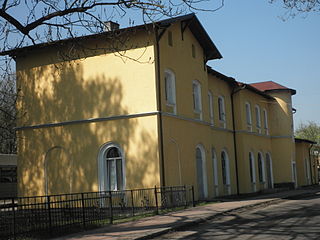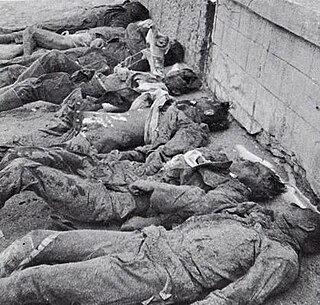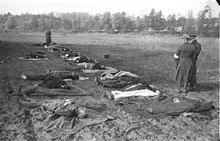
During the later stages of World War II and the post-war period, Germans and Volksdeutsche fled and were expelled from various Eastern and Central European countries, including Czechoslovakia, and from the former German provinces of Lower and Upper Silesia, East Prussia, and the eastern parts of Brandenburg (Neumark) and Pomerania (Hinterpommern), which were annexed by Poland and the Soviet Union.

East Prussia was a province of the Kingdom of Prussia from 1773 to 1829 and again from 1878 ; following World War I it formed part of the Weimar Republic's Free State of Prussia, until 1945. Its capital city was Königsberg. East Prussia was the main part of the region of Prussia along the southeastern Baltic Coast.
A Terrible Revenge: The Ethnic Cleansing of the East European Germans, 1944–1950 is a 1994 non-fiction book written by Cuban-born American lawyer Alfred-Maurice de Zayas, former research fellow at MPG in Heidelberg, Germany. The work is based on a collection of testimonials from German civilians and Wehrmacht military personnel; and devoted to the expulsion of Germans after World War II from states previously occupied by Nazi Germany. It includes as well selected interviews with British and American politicians who participated at the Potsdam Conference, including Robert Murphy, Geoffrey Harrison, and Denis Allen. The book attempts to describe the crimes committed against the German nation by the Soviet Union, Poland, Czechoslovakia, Hungary and Yugoslavia at the end of World War II – as perceived by the expellees themselves and settlers brought in Heim ins Reich from the east.

Wolf children or Little Germans were German and Prussian Lithuanian street children that existed in East Prussia at the end of World War II. Wolf children were mostly orphans left behind in the Evacuation of East Prussia and Red Army invasion in early 1945, with many living homeless in the forests of East Prussia or adopted by Lithuanian families.

Joachim Peiper was a German Schutzstaffel (SS) officer and war criminal convicted for the Malmedy massacre of U.S. Army prisoners of war (POWs). During the Second World War in Europe, Peiper served as personal adjutant to Heinrich Himmler, leader of the SS, and as a tank commander in the Waffen-SS. German historian Jens Westemeier writes that Peiper personified Nazi ideology, as a purportedly ruthless glory-hound commander who was indifferent to the combat casualties of Battle Group Peiper, and who encouraged, expected, and tolerated war crimes by his Waffen-SS soldiers.

The evacuation of East Prussia was the movement of German civilian population and military personnel from East Prussia between 20 January and March 1945, that was initially organized and carried out by state authorities but quickly turned into a chaotic flight from the Red Army.

The Gardelegen massacre was a massacre perpetrated by the local population of the northern German town of Gardelegen, with minor direction from the SS, near the end of World War II. On April 13, 1945, on the Isenschnibbe estate near the town, the troops forced over 1,000 slave laborers who were part of a transport train evacuated from the Mittelbau-Dora and Hannover-Stöcken concentration camps into a large barn, which was then set on fire.

Marion Hedda Ilse Gräfin von Dönhoff was a German journalist and publisher who participated in the resistance against Nazism, along with Helmuth James Graf von Moltke, Peter Yorck von Wartenburg, and Claus Schenk Graf von Stauffenberg. After the war, she became one of Germany's leading journalists and intellectuals, working for over 55 years as an editor and later publisher of the Hamburg-based weekly newspaper Die Zeit.
During World War II, the Allies committed legally proven war crimes and violations of the laws of war against either civilians or military personnel of the Axis powers. At the end of World War II, many trials of Axis war criminals took place, most famously the Nuremberg Trials and Tokyo Trials. In Europe, these tribunals were set up under the authority of the London Charter, which only considered allegations of war crimes committed by people who acted in the interests of the Axis powers. Some war crimes involving Allied personnel were investigated by the Allied powers and led in some instances to courts-martial. Some incidents alleged by historians to have been crimes under the law of war in operation at the time were, for a variety of reasons, not investigated by the Allied powers during the war, or were investigated but not prosecuted.

During World War II, the German Wehrmacht committed systematic war crimes, including massacres, mass rape, looting, the exploitation of forced labour, the murder of three million Soviet prisoners of war, and participated in the extermination of Jews. While the Nazi Party's own SS forces was the organization most responsible for the genocidal killing of the Holocaust, the regular armed forces of the Wehrmacht committed many war crimes of their own, particularly on the Eastern Front.

The war crimes and crimes against humanity which were perpetrated by the Soviet Union and its armed forces from 1919 to 1991 include acts which were committed by the Red Army as well as acts which were committed by the country's secret police, NKVD, including its Internal Troops. In many cases, these acts were committed upon the orders of the Soviet leaders Vladimir Lenin and Joseph Stalin in pursuance of the early Soviet government's policy of Red Terror. In other instances they were committed without orders by Soviet troops against prisoners of war or civilians of countries that had been in armed conflict with the USSR, or they were committed during partisan warfare.

Mayakovskoye is a rural locality in Gusevsky District of Kaliningrad Oblast, Russia, located on the banks of the Angrapa River. It lies approximately 11 kilometres (7 mi) south-west of Gusev.

The German evacuation from Central and Eastern Europe ahead of the Soviet Red Army advance during the Second World War was delayed until the last moment. Plans to evacuate people to present-day Germany from the territories controlled by Nazi Germany in Central and Eastern Europe, including from the former eastern territories of Germany as well as occupied territories, were prepared by the German authorities only when the defeat was inevitable, which resulted in utter chaos. The evacuation in most of the Nazi-occupied areas began in January 1945, when the Red Army was already rapidly advancing westward.
The 562nd Grenadier Division was an infantry division of Nazi Germany's Wehrmacht.

The Metgethen massacre was a massacre of German civilians by the Red Army in the Königsberg, East Prussia, suburb Metgethen, which is now Imeni Alexandra Kosmodemyanskogo in Russia's Kaliningrad Oblast, circa January–February 1945.

Imeni Alexandra Kosmodemyanskogo is a residential area in Tsentralny Administrative District of the city of Kaliningrad in Kaliningrad Oblast, Russia. It was formerly known by its German language name Metgethen as first a suburb of and then a quarter of Königsberg, located west of the city center.

The Gumbinnen Operation, also known as the Goldap Operation, was a Soviet offensive on the Eastern Front late in 1944, in which forces of the 3rd Belorussian Front attempted to penetrate the borders of East Prussia.
Bernhard Fisch was a German writer.
The Massacre of Grischino was a war crime committed by members of the Red Army in February 1943 in the eastern Ukrainian town of Krasnoarmeyskoye, earlier named Postyschewo and Grischino. A total of 596 prisoners of war, nurses, construction workers and female communication personnel (Nachrichtenhelferinnen) were killed. The Wehrmacht Untersuchungsstelle also known as WuSt, announced that among the victims were 406 soldiers of the Wehrmacht, 58 members of the Organisation Todt, 89 Italian soldiers, nine Romanian soldiers, four Hungarian soldiers, 15 German civil officials, seven German civilian workers and eight Ukrainian volunteers.

The Massacre of Feodosia was a war crime by the Red Army against 160 wounded Wehrmacht POWs between December 29, 1941 and January 1, 1942. The massacre was notable for the relatively high number of victims and the "needless cruelty demonstrated" by the Red Army murderers, who froze victims into ice alive.














